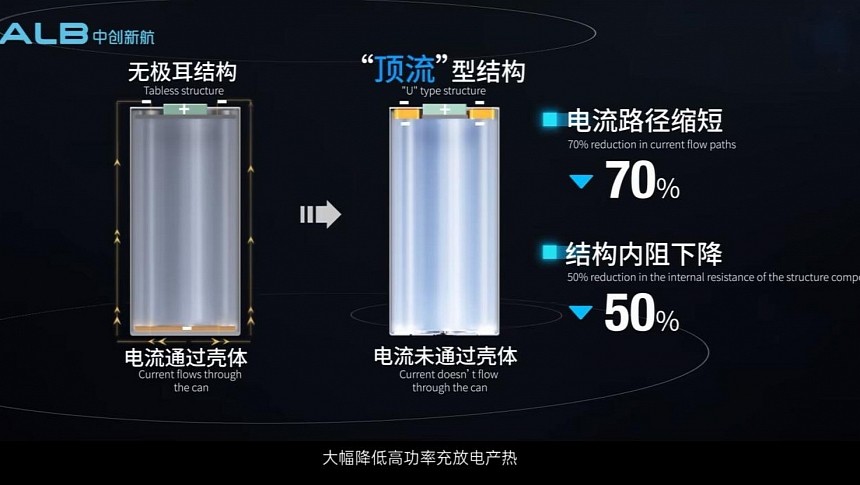Battery technology keeps improving as electric vehicles are produced in large quantities. CALB, a Chinese battery manufacturer, claims its "U-type" battery structure offers higher energy density and faster charging speeds than regular cylindrical cells.
Battery development doesn't seem to advance as fast as people would want, but progress is visible. Besides scientists' efforts to develop new chemistries and improve existing ones, battery manufacturers are also working on pushing the boundaries of current Li-Ion technology. Fine-tuning the packaging, manufacturing, and chemistry can yield tangible improvements that, in the case of electric vehicles, mean squeezing more miles from a battery charge.
These small improvements can make a difference, especially for companies that fight their way up the supply chain ladder. CALB is a relatively small Li-Ion battery supplier from China, at least when compared to the industry leader CATL. The Chinese company reported a 4% global market share in 2022, placing seventh among the biggest Li-Ion cell manufacturers. During a recent event in China, CALB introduced a new battery technology based on structural and chemical innovations developed in-house.
CALB's U-type cells represent a departure from the tabless design that has become popular for cylindrical cells. CALB vice president Xie Qiu explained that a tabless structure does improve some of the current path problems. Treating the cell's shell as a conductive component results in a relatively long path for the current to flow through. To make matters worse, the shell is made of steel, which doesn't conduct electricity very well.
The U-type structure CALB presented at China EV 100 Forum offers advantages over traditional cylindrical batteries thanks to a current flow path reduced by 70 percent and space utilization improved by 3 percent. This allows the battery to reduce structural components' electrical resistance by 50 percent, maximizing current. CALB claims its new battery supports fast charging at more than 6C, which means a full charge takes one-sixth of an hour or ten minutes.
Structural innovations also improve energy density, and CALB claims 300 Wh/kg when an NCM (Nickel-Cobalt-Manganese) chemistry is used. With LFP (Lithium-Iron-Phosphate) and LMFP (Lithium-Manganese-Iron-Phosphate) chemistries, the energy density is lower, at 200 Wh/kg. The new technology not only improves battery performance, but also simplifies manufacturing, promising lower production costs. Qiu says the number of welding machines on the production line can be reduced by about 70 percent compared to the tabless design.
CALB battery technology aims to compete with CATL's cell-to-pack (CTP) batteries, which entered mass production last month. CATL claimed its LFP-based Qilin battery offers a 255 Wh/kg energy density thanks to clever CTP 3.0 packaging. CATL said its Qilin battery delivers 13 percent more power than Tesla's 4680 batteries when using the same chemistry and similar pack sizes. It also claimed improved safety, longevity, and low-temperature performance.
These small improvements can make a difference, especially for companies that fight their way up the supply chain ladder. CALB is a relatively small Li-Ion battery supplier from China, at least when compared to the industry leader CATL. The Chinese company reported a 4% global market share in 2022, placing seventh among the biggest Li-Ion cell manufacturers. During a recent event in China, CALB introduced a new battery technology based on structural and chemical innovations developed in-house.
CALB's U-type cells represent a departure from the tabless design that has become popular for cylindrical cells. CALB vice president Xie Qiu explained that a tabless structure does improve some of the current path problems. Treating the cell's shell as a conductive component results in a relatively long path for the current to flow through. To make matters worse, the shell is made of steel, which doesn't conduct electricity very well.
The U-type structure CALB presented at China EV 100 Forum offers advantages over traditional cylindrical batteries thanks to a current flow path reduced by 70 percent and space utilization improved by 3 percent. This allows the battery to reduce structural components' electrical resistance by 50 percent, maximizing current. CALB claims its new battery supports fast charging at more than 6C, which means a full charge takes one-sixth of an hour or ten minutes.
Structural innovations also improve energy density, and CALB claims 300 Wh/kg when an NCM (Nickel-Cobalt-Manganese) chemistry is used. With LFP (Lithium-Iron-Phosphate) and LMFP (Lithium-Manganese-Iron-Phosphate) chemistries, the energy density is lower, at 200 Wh/kg. The new technology not only improves battery performance, but also simplifies manufacturing, promising lower production costs. Qiu says the number of welding machines on the production line can be reduced by about 70 percent compared to the tabless design.
CALB battery technology aims to compete with CATL's cell-to-pack (CTP) batteries, which entered mass production last month. CATL claimed its LFP-based Qilin battery offers a 255 Wh/kg energy density thanks to clever CTP 3.0 packaging. CATL said its Qilin battery delivers 13 percent more power than Tesla's 4680 batteries when using the same chemistry and similar pack sizes. It also claimed improved safety, longevity, and low-temperature performance.






